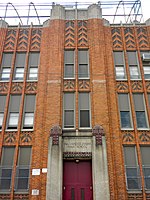Cecil B. Moore station

Cecil B. Moore, also known as Cecil B. Moore/Temple University, formerly Columbia, is a subway stop on the SEPTA Broad Street Line in the Cecil B. Moore neighborhood in North Philadelphia, Pennsylvania. It is a local station that has four tracks, with only the outer two being served. There are separate fare control areas for northbound and southbound trains, with no crossover, and a large pavilion entrance with an escalator on the northbound side. This is the main station serving Temple University, and therefore is one of the busiest stops on the line. Susquehanna–Dauphin station, six blocks north, also serves Temple University, although it is further from many of the main locations on campus. Surface Transit Connections: Until February 4, 1956 - Trolley SEPTA Route 3 (now a bus line) serve as the connection. As of June 2007, Cecil B. Moore had an average of 5,644 daily boardings.
Excerpt from the Wikipedia article Cecil B. Moore station (License: CC BY-SA 3.0, Authors, Images).Cecil B. Moore station
North Broad Street, Philadelphia
Geographical coordinates (GPS) Address Nearby Places Show on map
Geographical coordinates (GPS)
| Latitude | Longitude |
|---|---|
| N 39.98 ° | E -75.157 ° |
Address
Temple University
North Broad Street 1801
19122 Philadelphia
Pennsylvania, United States
Open on Google Maps






